Multi-Axis Workholding System Uses Three-Side Dovetail
The Get-A-Grip pedestal fixture for five-axis workholding uses a triangular clamping geometry for the matching workpiece and clamping dovetails.
Several workholding systems for multi-axis machining rely on the clamping force between a shallow dovetail “strip” machined on the clamping side of a workpiece and a matching “slot” on a pedestal fixture. Secure clamping is achieved by tightening the movable side of the slot against the dovetail strip on the workpiece to lock it on the stationary side of the slot.
A new system from AMT Innovations (Orchard Park, New York) is based on a variation of this concept that uses a triangular clamping geometry for the matching workpiece and clamping fixture. The stainless steel pedestal fixture features a shallow clamping pad with three sides bearing a dovetail profile. One side of this pad is stationary. The other part of the pad, which moves to lock and unlock the clamping function, has two adjacent sides with the matching dovetail profile. These sides of the movable portion of the pad form the corner of the triangle opposite the stationary side.
To interface with this triangular clamping pad, the clamping side of the workpiece must have a triangular pocket with an undercut that matches the dovetail profile of the pad. The sides of this triangular pocket are the same length. When the clamping pad is in the unlocked position, the workpiece pocket fits over it so the workpiece rests on the top of the pedestal fixture. Tightening the locking screw draws the movable portion of the locking pad against the two free sides of the workpiece pocket. When full clamping pressure is achieved, the triangular dovetail geometry provides three evenly spaced, radial-force vectors.
Developers claim these even-force vectors do not deform or distort the workpiece while creating more secure gripping than the conventional dovetail clamping systems. This clamping geometry is also said to enable reliable repeatability in part removal and reclamping. The three corners of the clamping pad and the workpiece pocket are rounded with a matching radius. Without the corner radius, each side of the triangle is 1.0 inch long.
The manufacturer is calling this clamping system Get-A Grip. The basic pedestal fixture for the system was introduced at a machine tool distributor’s customer event in late January. This pedestal fixture is available now, while other models will be available later this year. Other components of the modular system are being developed and will be released as they are completed.
This pedestal fixture is similar to other multi-axis workholding systems. It provides bolt holes so that it can be mounted on a machine worktable or upright workholding block. The fixture also lifts the workpiece from the mounting surface so that a cutting tool moving in multiple axes can reach the four sides and top of the workpiece. In a manner of speaking, the pedestal gives the machining head some “elbow room” to tilt and rotate into position without bumping the top of the table or mounting block. Developers say the new system is appropriate for five-axis simultaneous machining as well as 3+2 positioning.
The internal clamping geometry of the workpiece pocket can be located strategically where the finished part may have a larger pocket by design. If this clamping surface butts up against a wall in an assembly work but does not otherwise interfere with the design or function of the part, it can simply be left in place. Otherwise, the surface with the pocket must be removed in the same manner that the dovetail strip required for other systems must be removed.
AMT Innovations offers standard solid carbide form tools that produce the required dovetail and associated material prep features. These tools are available for ferrous and nonferrous materials.
Related Content
10 Things to Know About Creep-Feed Grinding
Because of the high material removal rate creep-feed grinding can deliver in challenging materials, grinding might not be just the last step in the process—it might be the process.
Read MoreHow to Reduce Cycle Times by 70% and More on Your Existing CNCs and Dramatically Improve Tool Life Too
By employing advanced high efficiency milling techniques for the entire machining routine, SolidCAM’s iMachining technology can drastically reduce cycle times while vastly improving tool life compared to traditional milling.
Read MoreWhen Organic Growth in Your Machine Shop Isn’t Enough
Princeton Tool wanted to expand its portfolio, increase its West Coast presence, and become a stronger overall supplier. To accomplish all three goals at once, acquiring another machine shop became its best option.
Read MoreUnderstanding Swiss-Type Machining
Once seen as a specialty machine tool, the CNC Swiss-type is increasingly being used in shops that are full of more conventional CNC machines. For the newcomer to Swiss-type machining, here is what the learning curve is like.
Read MoreRead Next
3 Mistakes That Cause CNC Programs to Fail
Despite enhancements to manufacturing technology, there are still issues today that can cause programs to fail. These failures can cause lost time, scrapped parts, damaged machines and even injured operators.
Read MoreObscure CNC Features That Can Help (or Hurt) You
You cannot begin to take advantage of an available feature if you do not know it exists. Conversely, you will not know how to avoid CNC features that may be detrimental to your process.
Read MoreThe Cut Scene: The Finer Details of Large-Format Machining
Small details and features can have an outsized impact on large parts, such as Barbco’s collapsible utility drill head.
Read More














.png;maxWidth=300;quality=90)


.png;maxWidth=300;quality=90)











